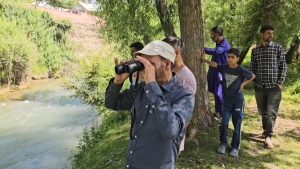 Anantnag, June 10: Eurasian Otter, locally known as Waddur, may have made a comeback to Kashmir with recent sightings reported from Bijbehara, officials from the Wildlife Department said on Tuesday.
Anantnag, June 10: Eurasian Otter, locally known as Waddur, may have made a comeback to Kashmir with recent sightings reported from Bijbehara, officials from the Wildlife Department said on Tuesday.
Dismissing social media rumours of a crocodile sighting, officials clarified that the habitat and climatic conditions of the Valley are not suitable for crocodiles.
Sohail Ahmad, Wildlife Warden South, said, “As far as our valley is concerned, it is a temperate climate. Crocodiles are mostly found in tropical areas where there is hot water. Their habitat is mostly in settled waters, where the water is stagnant and there is a lot of food availability. They are found in big rivers. But in Kashmir Valley, there is no historical record of crocodiles, except for the one reported in 1924 in Srinagar.”
“It is a cold-blooded animal, mostly found in hot areas. It does not have a habitat in cold areas,” he added.
Referring to the Bijbehara sighting, Ahmad said, “As far as our habitat analysis has been done, I think it is a Eurasian Otter. There are a lot of historical records of Eurasian Otters in our valley. It used to be in many places.”
The Eurasian otter is a water-loving animal found in Europe, Asia, and North Africa. It has a slim body, webbed feet, and thick fur that keeps it dry. It lives in rivers, lakes, and coasts, eating mostly fish. This otter is a sign of clean waterways but is at risk due to habitat loss.
Citing earlier habitats, he said, “In the tributary of Dal Lake, Dachigam Nala, and Rambi Nala. In all these areas, there used to be a large number of Eurasian otters. But for many years, we were not getting any evidence. We thought it might have gone extinct.”
He said recent evidence from different areas suggests the species may be reappearing. “Recently, we got footage from Gurez Valley and from Hirpora Wildlife Sanctuary in Rambiara. Now, this is our third footage from Lidder Nala.”
“We have installed camera traps in many places. We will monitor it continuously for two to three months and update based on the evidence and footage we get,” Ahmad said.
Appealing to the public, he added, “People should not pay attention to fake news. A crocodile cannot live here in this cold water. It is most probably a Eurasian otter. We have installed camera traps there, so there is no need to worry.”
“Eurasian otter is a good animal. It does not harm humans. It lives in its habitat in water and eats fish. There is no need to worry,” he said.







